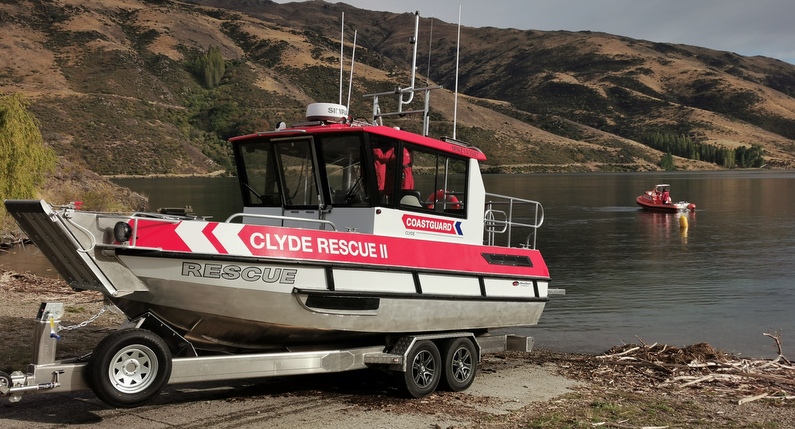
Clyde Rescue II
A one-of-a-kind Coastguard Rescue Vessel, now operational on Central Otago’s lakes and rivers.
Alongside local iwi representatives and members of the wider Coastguard community, Central Otago Mayor Tim Cadogan blessed Clyde Rescue II on 4 May. This unique vessel is specifically designed for its operational context, with a suite of modern technology providing a significant improvement in safety, comfort and capability for Coastguard Clyde.
Central Otago’s waterways, terrain and climate provide some specific operational challenges. Although they regularly respond to boating incidents on Lakes Dunstan and Roxburgh, volunteers also frequently support land-focused operations.
“The number of cycle and walking trails in the region has grown significantly in recent years,” says Chris Thornton, Southern Lakes and Seas Unit Support Manager at Coastguard. “Many locations are difficult or impossible to access by road, which means Coastguard Clyde is often called to assist.”
Clyde Rescue II’s unique folding bow door is a key enabler for these operations. Manually operated by a crew member, the door enables convenient, dry access to shore, which is a game changer for transporting stretcher-bound patients, or in sub-zero winter conditions.
The tall, semi-enclosed cabin provides warmth in winter, and shade during summers that reach nearly 40 degrees celsius. “Collaborating with emergency services, other SAR agencies and commercial users is always on our mind when conducting an operation,” says Chris. “As well as responding to search and rescue incidents, the vessel can transport and deploy personnel and resources from partner agencies to aid the outcome of the task.” A large open space at the bow allows for carriage of such ancillary equipment.
Clyde Rescue II, with its distinctive and unique folding bow door has a suite of advanced electronics that provide a large boost to safety and operational effectiveness.
A modern GPS plotter provides accurate navigation information, and powerful radio gear provides enhanced communication reach from the deep valleys where these lakes and rivers are often located.Because many of these waterways are narrow, the crew is often operating in close proximity to shore, which is particularly difficult at night. The new vessel is equipped with a Syonix Low light camera, providing enhanced collision avoidance and operating effectiveness in those situations.
Powered by a trimmable 215 Hamilton Jet unit, the 7-metre-long rescue vessel is well suited for its operational area, encompassing nearly 4,000 square kilometres. The area’s rivers, lakes and dams all have shallow zones and underwater hazards. Detecting and avoiding these hazards is one function of the vessel’s StructureScan 3D Sonar; searching for objects of interest is another. “The volunteers have the capability to scan parts of the river and lake bed during a search, which may help in the detection of these objects,” says Chris.
This vessel is the culmination of a two year project with countless hours of volunteer time dedicated to planning, development, fundraising and project management. Financial support from Coastguard Tautiaki Moana, Lottery Grants Board, Central Lakes Trust, local sponsors, public contributions, and the Unit’s own funds, has brought this $500,000 project to life.
“We’re so excited to welcome Clyde Rescue II to our fleet,” says Coastguard Clyde President James Robinson. “Our new vessel represents not only an upgrade in our equipment but also our investment in our volunteers and setting up the Unit for future success. The next step is bringing in a new wave of committed volunteers to help support the community on its waterways.”
Feature image: Clyde Rescue II. Courtesy Barrie Wills
Enjoy this story?
Sign up to our Link Newsletter to receive stories like this plus NZSAR news and announcements direct to your inbox, every six weeks.
Follow NZSAR on LinkedIn for more SAR news, announcements and discussion.
This story was originally published in the June 2024 issue of Link magazine, which is produced by the NZSAR Secretariat for the wider search and rescue sector.
